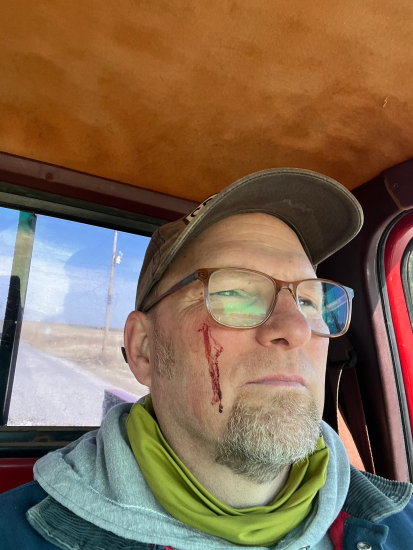Who doesn’t take a selfie with blood running down their face?

It’s hard on a preacher to sweat.
Jerry and Beth lived across the street from the parsonage on OK 5 in Gould, Oklahoma. We became fast friends in the short time we lived in southwest Oklahoma. Late-night card games and an occasional offer to learn another aspect of farm life were commonplace. One day while riding to take up the task of hauling hay, Jerry told me,
Thanks for reading Can We Talk? ! Subscribe for free to receive new posts and support my work.
Subscribed
It is hard on a preacher to sweat.
His wry smile betrayed his seriousness. Jerry is a natural comedian.
Chopping cotton. Hauling hay. Cutting calves. All sweat-producing activities, especially in the river bottom! I concluded the work was harder than the sweat.
Thorns and thistles it shall bring forth.
Fast forward more than thirty years. Last December a group of us began laying out a new disc golf course on floodway land owned by the City of Tuttle. The center of the floodway is heavily wooded and has been subject to at least a couple of ice storms over time. Not far east of the small waterway that runs through the trees is the largest cottonwood tree I have ever seen. More near the creek bed are other trees that soar skyward.
Our first workday presented a challenge. Nearly everywhere we turned to work, we found a green thorny vine. We wrapped a chain around some 20-30 vines hanging from a single tree and pulled them down with a tractor. We had gloves but not the sort that would withstand the skin-piercing thorns.
We faced these vines down when taking out barbed wire, dead trees, and other debris in the lanes we plan to use as fairways.
Last week we worked to remove another section of barbed wire. The thorny vines we have come to despise wrap around small trees, t-posts, and bois d’arc posts. I was working to remove a section of vines so the fellows following me could remove the barbed wire. One vine was tight, and when I cut it, it flung back toward my face. I ducked but not soon enough. One of the thorns caught my cheek. Bill, working near me, told me I was bleeding. Timmy told me I was bleeding. Brett wondered what had happened.
I wiped the blood with the back of my gloves and the sleeve of my coveralls. Finally, I decided that it would just have to stop on its own. It did not hurt. It just looked like I had been battling Rambo.
Good Thorny Vines?
All of us working in the woods have talked about what we can do to rid the area of these thorny vines. I took to the Google Machine that afternoon. The best I can tell is we are dealing with greenbrier.

While reading how to get rid of greenbrier, I learned some things about the nuisance. It has some good qualities. For instance, if you get lost in the woods and happen on to greenbrier, the soft end of the vine is safe to eat. The vine produces berries for deer and, birds, even humans. One reason the vine seems to be everywhere? Berry seeds end up working their way through the animals and deposited, well, on the ground.
There is another reason for their spread. Greenbrier is a rhizome. Here in our part of the country, we call another rhizome Bermuda grass. Think of working your flower beds in the summer. You have watered your flower bed and see these shoots of green reaching toward the moist ground; these are stolons. We have a dirt border between our flower bed and yard. Occasionally we will see a Bermuda shoot in our flower bed and wonder how this happened. The roots of Bermuda are doing what rhizomes do. They run just under the surface of the ground, putting out grass shoots along the way.
Greenbrier, a rhizome, does the same thing. The roots run below the surface of the ground and produce vines that shoot up out of the ground and grow toward the sun. Greenbrier will grow upward until it reaches something above it. Once it finds a low-hanging branch or a t-post, it will begin winding its way upward. We have pulled vines from trees up to 30’ in the air!
Maybe we will thin the greenbriers.
Rather than kill out all the greenbriers, we may thin the vines by thinning the roots. Speculating here, but it seems like the thorns protect the vine from being eaten too soon, allowing it to grow both leaves and the tender shoots that become food and produce berries in its season. Birds still need food. Deer will likely run the waterway in search of water and food in the safety of the woods. Maybe a hungry disc golfer will need a snack. They can dig up the root for another snack option if the berries are not present.
We will have to be more careful in trimming the greenbrier, but we may not want to affect the habitat to run off the animals and deprive the humans. Snakes are another story. We hope we have stirred their habitat enough they will move on when Spring comes.
Who would have thought that we may need to learn to live with thorns and thistles, given our tendency to be wild ourselves.
Human relationships may mean that we will occasionally run into a thorny vine. We may find the benefits of friendship we never imagined possible with grace and patience.
I have.
Here is another way to keep up with more of my current writing, as sporadic as it may be,